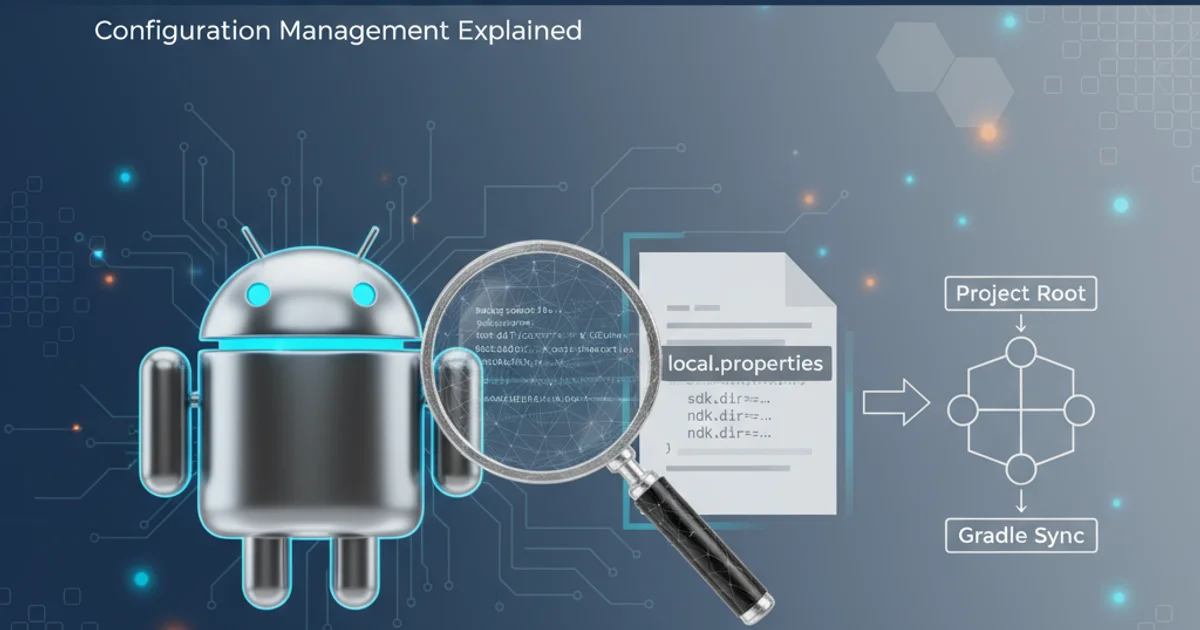Where does local.properties go for android project?
Categories:
Understanding local.properties in Android Projects

Discover the purpose, location, and best practices for managing your local.properties file in Android development, especially within IntelliJ IDEA.
The local.properties file is a crucial, yet often overlooked, component in Android development. It serves as a repository for local machine-specific configurations that should not be committed to version control. Understanding its role and correct placement is essential for smooth project setup and collaboration, especially when working with IDEs like IntelliJ IDEA or Android Studio.
What is local.properties and Why is it Needed?
The local.properties file is a simple key-value pair file primarily used by the Android Gradle plugin to locate the Android SDK installation on your development machine. It typically contains a single entry: sdk.dir=/path/to/your/android/sdk.
The main reason for its existence and why it's excluded from version control (via .gitignore) is that the Android SDK path varies from developer to developer and across different operating systems. Committing this file would lead to constant conflicts and broken builds for other team members. It's designed to be generated and maintained locally by each developer or IDE.
flowchart TD
A[Android Project] --> B{Gradle Build System}
B --> C[Reads build.gradle]
C --> D{Needs SDK Location?}
D -- Yes --> E[Looks for local.properties]
E -- Found --> F[Uses sdk.dir from local.properties]
E -- Not Found --> G[Build Fails / Prompts for SDK]
D -- No --> H[Continues Build]Flowchart illustrating how Gradle uses local.properties to locate the Android SDK.
Where Does local.properties Go?
The local.properties file should always reside in the root directory of your Android project. This is the same directory where your build.gradle (project-level), settings.gradle, and .gitignore files are located. It should NOT be placed inside any module directories (e.g., app/) or in your user's home directory.
When you open an Android project in IntelliJ IDEA or Android Studio for the first time, if local.properties is missing, the IDE will usually prompt you to specify the SDK location and then automatically create this file for you in the correct place. If you're setting up a project manually or troubleshooting, you might need to create it yourself.
# This file must *NOT* be checked into Version Control Systems,
# as it contains information specific to your local setup.
# For more information, please refer to the Android SDK documentation.
sdk.dir=/Users/yourusername/Library/Android/sdk
# or on Windows:
# sdk.dir=C:\Users\yourusername\AppData\Local\Android\Sdk
Example content of a local.properties file.
local.properties is listed in your project's .gitignore file to prevent accidental commits. This is typically handled automatically when you create a new Android project.Troubleshooting Missing or Incorrect local.properties
If your Android project fails to build with errors related to the SDK not being found, the local.properties file is often the culprit. Here's how to address common issues:
- Missing File: If the file is entirely absent, create it manually in the project root and add the
sdk.direntry pointing to your Android SDK location. - Incorrect Path: Double-check the
sdk.dirpath. It must be the absolute path to your Android SDK installation. On macOS, it's often/Users/yourusername/Library/Android/sdk. On Windows, it's typicallyC:\Users\yourusername\AppData\Local\Android\Sdk. - IDE Sync Issues: Sometimes, after modifying the file, the IDE might not pick up the changes immediately. Try 'Sync Project with Gradle Files' (the elephant icon in Android Studio/IntelliJ IDEA) or invalidate caches and restart the IDE.
1. Locate your Android SDK
In Android Studio, go to File > Settings (Windows/Linux) or Android Studio > Preferences (macOS), then navigate to Appearance & Behavior > System Settings > Android SDK. The 'Android SDK Location' field shows the path.
2. Create or Edit local.properties
Open your project's root directory. If local.properties doesn't exist, create a new file named local.properties. Add or update the line sdk.dir=/path/to/your/android/sdk with the path you found in the previous step.
3. Sync Gradle Project
Return to your IDE. Click the 'Sync Project with Gradle Files' button (a small elephant icon with a refresh arrow) in the toolbar. This forces Gradle to re-evaluate the project configuration, including local.properties.